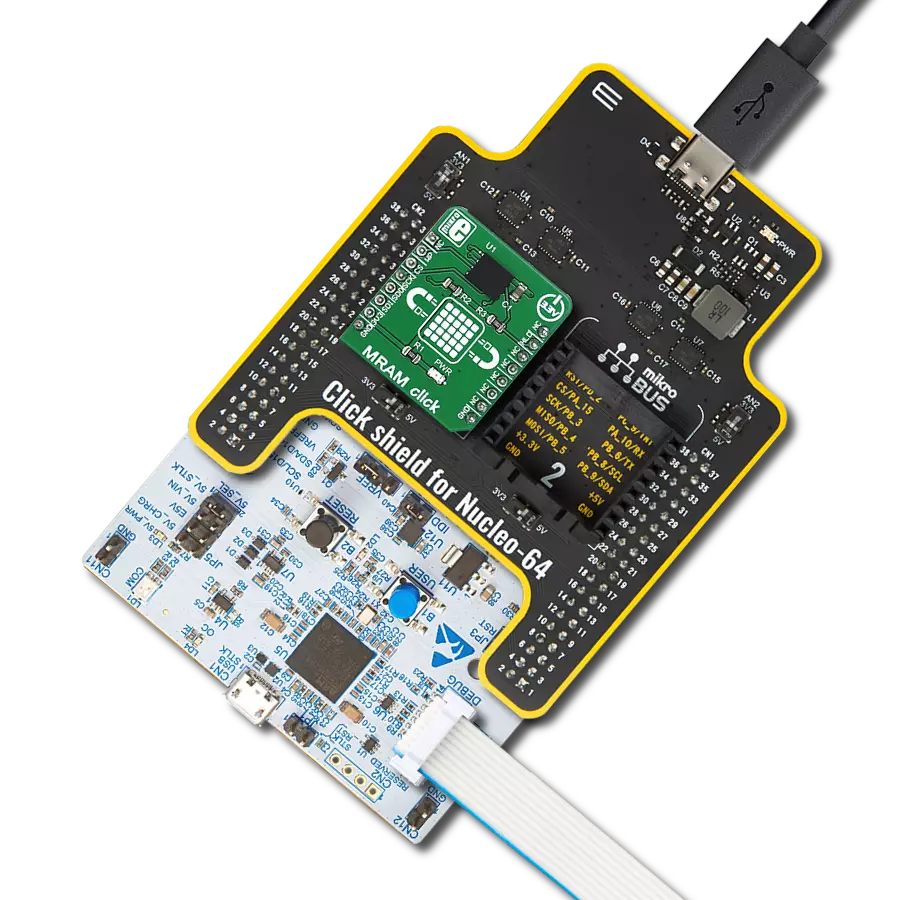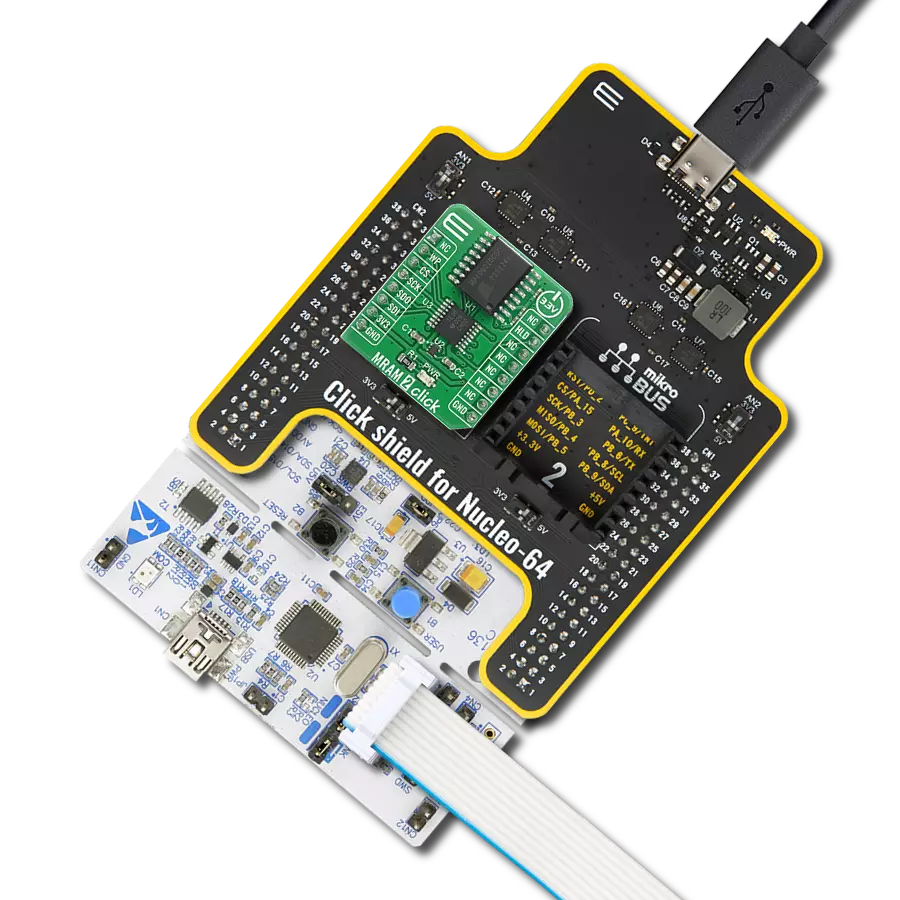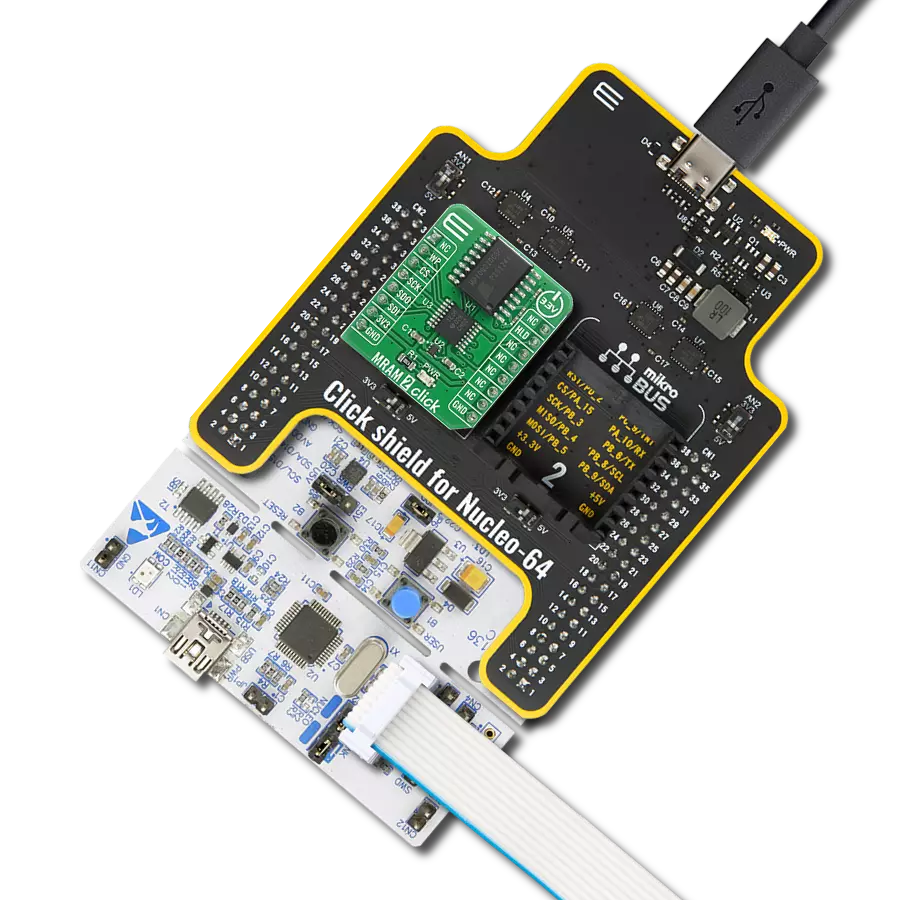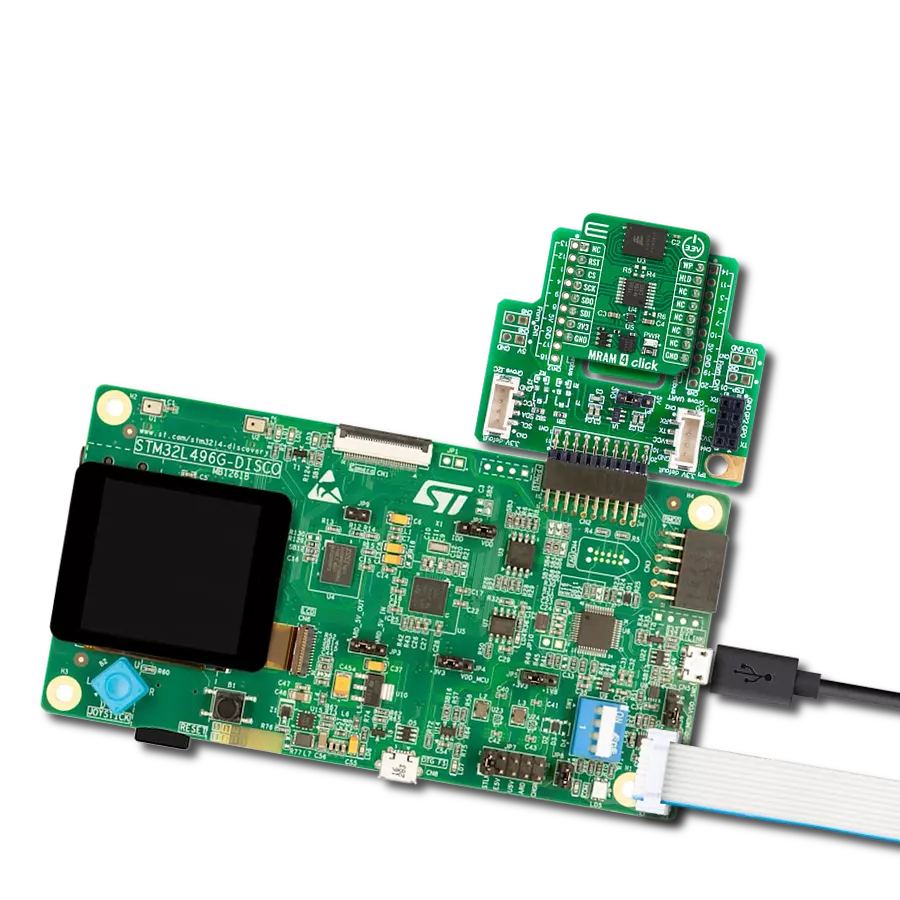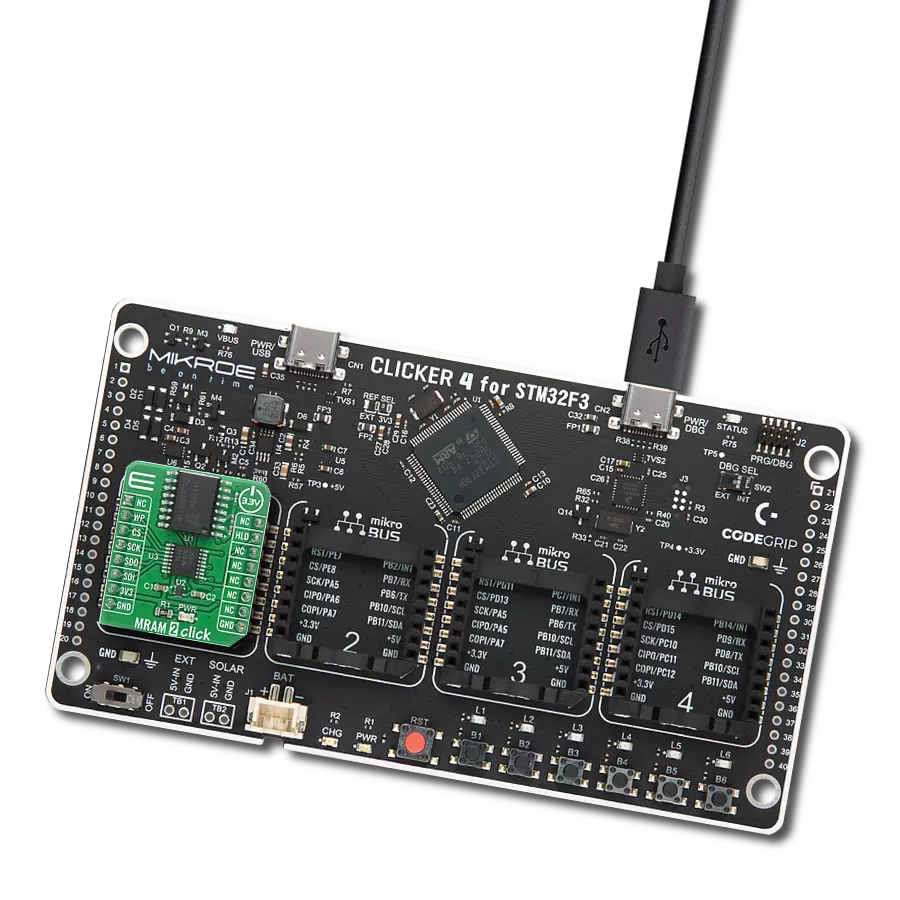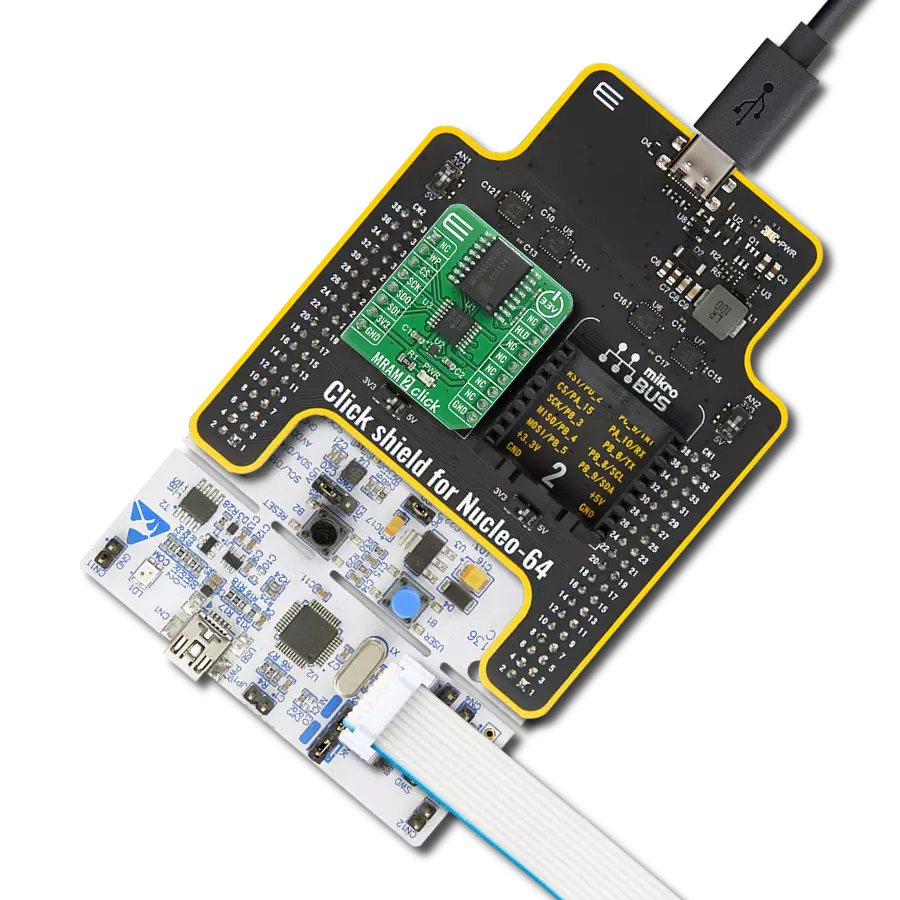Our MRAM memory solution sets a new standard in data storage technology, combining rapid access speeds with magnetic reliability for a seamless and efficient user experience.
A
A
Hardware Overview
How does it work?
MRAM 4 Click is based on the EM064LX, an industrial STT-MRAM persistent memory from Everspin Technologies. It can deliver up to 400Mbps reads and writes via eight I/O signals with a clock frequency of 200MHz. As this is a persistent memory, byte-level writes and reads do not require erasing. Nonvolatile settings are not reflow protected, which you have to keep in mind. A dedicated 256-byte OTP area outside the main memory is readable and user-lockable, with a permanent lock WRITE OTP command. The EM064LX is capable of chip/bulk and sector erase. Subsector erase is possible in 4KB, 32KB granularity. In addition, the MRAM memory features 16 configurable hardware write-protected
regions plus top/bottom select, program/erase protection during power-up, and CRC command to detect accidental changes to user data. As the EM064LX works at the recommended 1.8V voltage, the MRAM 4 Click is equipped with a BH18PB1WHFV, a CMOS LDO regulator from Rohm Semiconductor. To work with different logic level voltage, this Click board™ comes with a TXB0106, a 6-bit bidirectional level-shifting and voltage translator from Texas Instruments. On board, there are two unpopulated jumpers labeled R5 and R6. The chip select and write protection can be pulled up for further hardware development. MRAM 4 Click uses a standard 4-Wire SPI serial interface to communicate
with the host MCU. You can use write protection functionality over the WP pin. The hardware reset is available over the HLD pin, whereas in the low logic state, the memory will self-initialize and return the device to the ready state. There is an unpopulated R6 resistor for an external pull-up, as this pin shouldn’t be allowed to float. This Click board™ can be operated only with a 3.3V logic voltage level. The board must perform appropriate logic voltage level conversion before using MCUs with different logic levels. Also, it comes equipped with a library containing functions and an example code that can be used as a reference for further development.
Features overview
Development board
Nucleo-64 with STM32F103RB MCU offers a cost-effective and adaptable platform for developers to explore new ideas and prototype their designs. This board harnesses the versatility of the STM32 microcontroller, enabling users to select the optimal balance of performance and power consumption for their projects. It accommodates the STM32 microcontroller in the LQFP64 package and includes essential components such as a user LED, which doubles as an ARDUINO® signal, alongside user and reset push-buttons, and a 32.768kHz crystal oscillator for precise timing operations. Designed with expansion and flexibility in mind, the Nucleo-64 board features an ARDUINO® Uno V3 expansion connector and ST morpho extension pin
headers, granting complete access to the STM32's I/Os for comprehensive project integration. Power supply options are adaptable, supporting ST-LINK USB VBUS or external power sources, ensuring adaptability in various development environments. The board also has an on-board ST-LINK debugger/programmer with USB re-enumeration capability, simplifying the programming and debugging process. Moreover, the board is designed to simplify advanced development with its external SMPS for efficient Vcore logic supply, support for USB Device full speed or USB SNK/UFP full speed, and built-in cryptographic features, enhancing both the power efficiency and security of projects. Additional connectivity is
provided through dedicated connectors for external SMPS experimentation, a USB connector for the ST-LINK, and a MIPI® debug connector, expanding the possibilities for hardware interfacing and experimentation. Developers will find extensive support through comprehensive free software libraries and examples, courtesy of the STM32Cube MCU Package. This, combined with compatibility with a wide array of Integrated Development Environments (IDEs), including IAR Embedded Workbench®, MDK-ARM, and STM32CubeIDE, ensures a smooth and efficient development experience, allowing users to fully leverage the capabilities of the Nucleo-64 board in their projects.
Microcontroller Overview
MCU Card / MCU
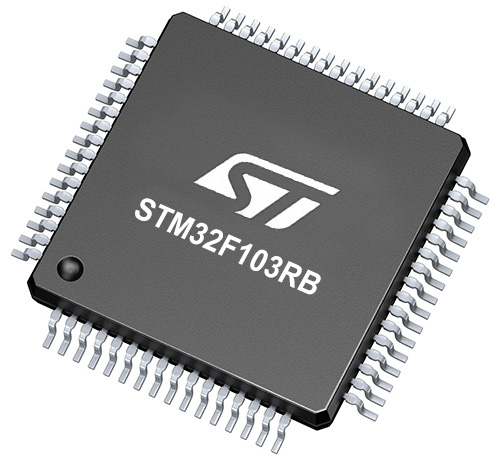
Architecture
ARM Cortex-M3
MCU Memory (KB)
128
Silicon Vendor
STMicroelectronics
Pin count
64
RAM (Bytes)
20480
You complete me!
Accessories
Click Shield for Nucleo-64 comes equipped with two proprietary mikroBUS™ sockets, allowing all the Click board™ devices to be interfaced with the STM32 Nucleo-64 board with no effort. This way, Mikroe allows its users to add any functionality from our ever-growing range of Click boards™, such as WiFi, GSM, GPS, Bluetooth, ZigBee, environmental sensors, LEDs, speech recognition, motor control, movement sensors, and many more. More than 1537 Click boards™, which can be stacked and integrated, are at your disposal. The STM32 Nucleo-64 boards are based on the microcontrollers in 64-pin packages, a 32-bit MCU with an ARM Cortex M4 processor operating at 84MHz, 512Kb Flash, and 96KB SRAM, divided into two regions where the top section represents the ST-Link/V2 debugger and programmer while the bottom section of the board is an actual development board. These boards are controlled and powered conveniently through a USB connection to program and efficiently debug the Nucleo-64 board out of the box, with an additional USB cable connected to the USB mini port on the board. Most of the STM32 microcontroller pins are brought to the IO pins on the left and right edge of the board, which are then connected to two existing mikroBUS™ sockets. This Click Shield also has several switches that perform functions such as selecting the logic levels of analog signals on mikroBUS™ sockets and selecting logic voltage levels of the mikroBUS™ sockets themselves. Besides, the user is offered the possibility of using any Click board™ with the help of existing bidirectional level-shifting voltage translators, regardless of whether the Click board™ operates at a 3.3V or 5V logic voltage level. Once you connect the STM32 Nucleo-64 board with our Click Shield for Nucleo-64, you can access hundreds of Click boards™, working with 3.3V or 5V logic voltage levels.
Used MCU Pins
mikroBUS™ mapper
Take a closer look
Click board™ Schematic

Step by step
Project assembly
Software Support
Library Description
This library contains API for MRAM 4 Click driver.
Key functions:
mram4_memory_write- MRAM 4 memory write function.mram4_memory_read- MRAM 4 memory read function.mram4_block_erase- MRAM 4 block erase function.
Open Source
Code example
The complete application code and a ready-to-use project are available through the NECTO Studio Package Manager for direct installation in the NECTO Studio. The application code can also be found on the MIKROE GitHub account.
/*!
* @file main.c
* @brief MRAM 4 Click example
*
* # Description
* This example demonstrates the use of MRAM 4 Click board.
* The demo app writes specified data to the memory and reads it back.
*
* The demo application is composed of two sections :
*
* ## Application Init
* The initialization of SPI module, log UART, and additional pins.
* After the driver init, the app executes a default configuration.
*
* ## Application Task
* The demo application writes a desired number of bytes to the memory
* and then verifies if it is written correctly
* by reading from the same memory location and displaying the memory content.
* Results are being sent to the UART Terminal, where you can track their changes.
*
* @author Nenad Filipovic
*
*/
#include "board.h"
#include "log.h"
#include "mram4.h"
static mram4_t mram4;
static log_t logger;
#define STARTING_ADDRESS 0x012345ul
#define DEMO_TEXT_MESSAGE_1 "MikroE"
#define DEMO_TEXT_MESSAGE_2 "MRAM 4 Click"
void application_init ( void )
{
log_cfg_t log_cfg; /**< Logger config object. */
mram4_cfg_t mram4_cfg; /**< Click config object. */
/**
* Logger initialization.
* Default baud rate: 115200
* Default log level: LOG_LEVEL_DEBUG
* @note If USB_UART_RX and USB_UART_TX
* are defined as HAL_PIN_NC, you will
* need to define them manually for log to work.
* See @b LOG_MAP_USB_UART macro definition for detailed explanation.
*/
LOG_MAP_USB_UART( log_cfg );
log_init( &logger, &log_cfg );
log_info( &logger, " Application Init " );
// Click initialization.
mram4_cfg_setup( &mram4_cfg );
MRAM4_MAP_MIKROBUS( mram4_cfg, MIKROBUS_1 );
if ( SPI_MASTER_ERROR == mram4_init( &mram4, &mram4_cfg ) )
{
log_error( &logger, " Communication init." );
for ( ; ; );
}
if ( MRAM4_ERROR == mram4_default_cfg ( &mram4 ) )
{
log_error( &logger, " Default configuration." );
for ( ; ; );
}
Delay_ms ( 100 );
log_info( &logger, " Application Task " );
log_printf( &logger, "-----------------------\r\n" );
Delay_ms ( 100 );
}
void application_task ( void )
{
uint8_t data_buf[ 128 ] = { 0 };
log_printf( &logger, " Memory address: 0x%.6LX\r\n", ( uint32_t ) STARTING_ADDRESS );
if ( MRAM4_OK == mram4_block_erase( &mram4, MRAM4_CMD_ERASE_4KB, STARTING_ADDRESS ) )
{
log_printf( &logger, " Erase memory block (4KB)\r\n" );
Delay_ms ( 100 );
}
memcpy( data_buf, DEMO_TEXT_MESSAGE_1, strlen( DEMO_TEXT_MESSAGE_1 ) );
if ( MRAM4_OK == mram4_memory_write( &mram4, STARTING_ADDRESS, data_buf, sizeof( data_buf ) ) )
{
log_printf( &logger, " Write data: %s\r\n", data_buf );
Delay_ms ( 100 );
}
memset( data_buf, 0, sizeof( data_buf ) );
if ( MRAM4_OK == mram4_memory_read( &mram4, STARTING_ADDRESS, data_buf, sizeof( data_buf ) ) )
{
log_printf( &logger, " Read data: %s\r\n", data_buf );
Delay_ms ( 1000 );
Delay_ms ( 1000 );
Delay_ms ( 1000 );
}
log_printf( &logger, " ----------------------------\r\n" );
log_printf( &logger, " Memory address: 0x%.6LX\r\n", ( uint32_t ) STARTING_ADDRESS );
if ( MRAM4_OK == mram4_block_erase( &mram4, MRAM4_CMD_ERASE_4KB, STARTING_ADDRESS ) )
{
log_printf( &logger, " Erase memory block (4KB)\r\n" );
}
memcpy( data_buf, DEMO_TEXT_MESSAGE_2, strlen( DEMO_TEXT_MESSAGE_2 ) );
if ( MRAM4_OK == mram4_memory_write( &mram4, STARTING_ADDRESS, data_buf, sizeof( data_buf ) ) )
{
log_printf( &logger, " Write data: %s\r\n", data_buf );
Delay_ms ( 100 );
}
memset( data_buf, 0, sizeof( data_buf ) );
if ( MRAM4_OK == mram4_memory_read( &mram4, STARTING_ADDRESS, data_buf, sizeof( data_buf ) ) )
{
log_printf( &logger, " Read data: %s\r\n", data_buf );
Delay_ms ( 1000 );
Delay_ms ( 1000 );
Delay_ms ( 1000 );
}
log_printf ( &logger, " ----------------------------\r\n" );
}
int main ( void )
{
/* Do not remove this line or clock might not be set correctly. */
#ifdef PREINIT_SUPPORTED
preinit();
#endif
application_init( );
for ( ; ; )
{
application_task( );
}
return 0;
}
// ------------------------------------------------------------------------ END
Additional Support
Resources
Category:MRAM


















